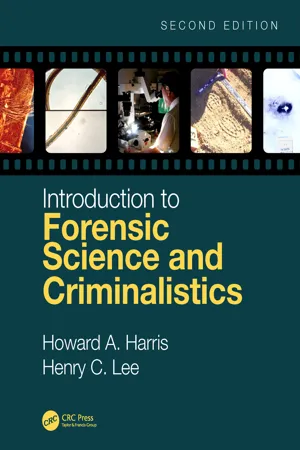
Introduction to Forensic Science and Criminalistics, Second Edition
- 420 pages
- English
- ePUB (mobile friendly)
- Available on iOS & Android
Introduction to Forensic Science and Criminalistics, Second Edition
About this book
This Second Edition of the best-selling Introduction to Forensic Science and Criminalistics presents the practice of forensic science from a broad viewpoint. The book has been developed to serve as an introductory textbook for courses at the undergraduate level—for both majors and non-majors—to provide students with a working understanding of forensic science.
The Second Edition is fully updated to cover the latest scientific methods of evidence collection, evidence analytic techniques, and the application of the analysis results to an investigation and use in court. This includes coverage of physical evidence, evidence collection, crime scene processing, pattern evidence, fingerprint evidence, questioned documents, DNA and biological evidence, drug evidence, toolmarks and fireams, arson and explosives, chemical testing, and a new chapter of computer and digital forensic evidence. Chapters address crime scene evidence, laboratory procedures, emergency technologies, as well as an adjudication of both criminal and civil cases utilizing the evidence. All coverage has been fully updated in all areas that have advanced since the publication of the last edition.
Features include:
- Progresses from introductory concepts—of the legal system and crime scene concepts—to DNA, forensic biology, chemistry, and laboratory principles
- Introduces students to the scientific method and the application of it to the analysis to various types, and classifications, of forensic evidence
- The authors' 90-plus years of real-world police, investigative, and forensic science laboratory experience is brought to bear on the application of forensic science to the investigation and prosecution of cases
- Addresses the latest developments and advances in forensic sciences, particularly in evidence collection
- Offers a full complement of instructor's resources to qualifying professors
- Includes full pedagogy—including learning objectives, key terms, end-of-chapter questions, and boxed case examples—to encourage classroom learning and retention
Introduction to Forensic Science and Criminalistics, Second Edition, will serve as an invaluable resource for students in their quest to understand the application of science, and the scientific method, to various forensic disciplines in the pursuit of law and justice through the court system.
An Instructor's Manual with Test Bank and Chapter PowerPoint® slides are available upon qualified course adoption.
Frequently asked questions
- Essential is ideal for learners and professionals who enjoy exploring a wide range of subjects. Access the Essential Library with 800,000+ trusted titles and best-sellers across business, personal growth, and the humanities. Includes unlimited reading time and Standard Read Aloud voice.
- Complete: Perfect for advanced learners and researchers needing full, unrestricted access. Unlock 1.4M+ books across hundreds of subjects, including academic and specialized titles. The Complete Plan also includes advanced features like Premium Read Aloud and Research Assistant.
Please note we cannot support devices running on iOS 13 and Android 7 or earlier. Learn more about using the app.
Information
Item | Examination | Findings/conclusion |
Tooth—Lake Zoar shoreline | Odontological and radiological: identified as Helle Crafts by comparison with ante-mortem dental X-rays | Tooth belonged to Helle Crafts |
Dental crown—Lake Zoar shoreline | Odontological: identification Criminalistics: trace metal analysis | Identified as belonging to Helle Crafts by the dentist; Trace metals linked to the laboratory that made the crown |
Bone chips—Lake Zoar shoreline | Anthropological and biological | human, from the head, hands and feet only; blood type O [A match to Helle’s type?] |
Sum of human remains—Lake Zoar shoreline | Pathology—Medical Examiner: cause and manner of death | Homicidal death based on the recovered bone chips; cause could not be determined |
Wood chips—Lake Zoar shoreline | Toolmark: compare with U-Haul wood chips and bone chips Wood identification: link type of wood | Chips consistent with one another (as having been made by the same cutting blade); consistent with having been made by the wood chipper; Linked type of wood to the wood lot (scene) |
Wood chips—U-Haul truck bed | Toolmark: compare with Lake Zoar wood chips and bone chips Wood identification: link type of wood | |
Hairs—Lake Zoar shoreline | Hair comparison: compare with hairs from chain saw and hair brush | Hairs consistent with one another, and inconsistent with Richard, the nanny, or any of the children |
Hairs—chain saw | Hair comparison: compare with hairs from chain saw and hair brush | |
Hairs—hair brush from Helle Crafts’ dressing table | Hair comparison: compare with hairs from chain saw and Lake Zoar shoreline | |
Tissue—chain saw | Biological | human, blood type O, PGM 1-1 |
Blood—chain saw | Biological | human, blood type O |
Blood—medium velocity spatter, from box spring in bedroom | Biological | human, blood type O, and yielded a PGM isoenzyme type 1-1, same as the tissue |
Blue-gr... |
Table of contents
- Cover
- Half Title
- Title Page
- Copyright Page
- Dedication
- Table of Contents
- Preface to Second Edition
- Acknowledgments
- About the Book and Pedagogy
- Authors
- Contributors
- 1 Introduction
- 2 Physical evidence in the legal system
- 3 Crime scene processing and analysis
- 4 Examination and interpretation of patterns for reconstruction
- 5 Examination of physical pattern evidence
- 6 Fingerprints and other personal identification patterns
- 7 Questioned document examination
- 8 Toolmarks and firearms
- 9 Digital evidence and computer forensics
- 10 Blood and physiological fluid evidence: Evaluation and initial examination
- 11 DNA analysis and typing
- 12 Arson and explosives
- 13 Drugs and drug analysis
- 14 Materials evidence
- Appendix A: J. Methods of forensic science—The scientific tools of the trade
- Index